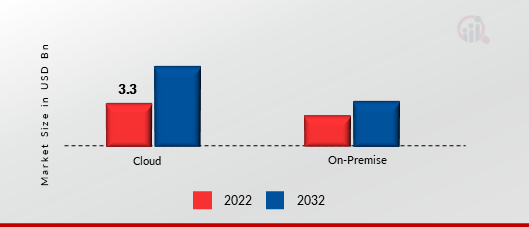Europe Simulation Software Market Overview
Europe Simulation Software Market Size was valued at USD 4.5 Billion in 2022. The Simulation Software market industry is projected to grow from USD 5.107 Billion in 2023 to USD 14.06 Billion by 2032, exhibiting a compound annual growth rate (CAGR) of 13.50% during the forecast period (2024 - 2032). The growing need for efficient software solutions in order to reduce production expenses and training costs is one of the major market drivers driving the Simulation Software market in Europe.
Figure 1: Europe Simulation Software Market Size, 2023-2032 (USD Billion)

Source: The Primary Research, Secondary Research, MRFR Database and Analyst Review
Simulation Software Market Trends
-
Growing adoption of innovative technologies in simulation tools is driving the market growth
The European Simulation Software market CAGR is expanding due to the surging adoption of innovative technologies in simulation tools. As industries across sectors such as manufacturing, automotive, aerospace, healthcare, and energy strive for efficiency, safety, and cost-effectiveness, simulation software emerges as a critical enabler. One of the key reasons boosting market growth is the integration of advanced technologies like artificial intelligence (AI), machine learning (ML), and virtual reality (VR) into simulation tools. These technologies enhance the accuracy, complexity, and capabilities of simulations, allowing for more realistic and comprehensive modeling of real-world scenarios. AI and ML algorithms are increasingly being incorporated into simulation software to optimize processes, predict outcomes, and automate decision-making. By leveraging vast amounts of data, AI-powered simulations can simulate complex systems with greater fidelity and efficiency, enabling engineers and analysts to explore a wide range of scenarios and identify optimal solutions. Moreover, AI-driven simulations facilitate real-time analysis and adaptive modeling, enabling organizations to respond swiftly to changing conditions and improve operational resilience. Virtual reality (VR) and augmented reality (AR) technologies are also revolutionizing the European simulation software market by providing immersive and interactive simulation experiences.
Furthermore, the growing emphasis on digital twin technology is fueling the adoption of simulation software across Europe. Digital twins, virtual replicas of the physical assets or systems, enable organizations to simulate and monitor real-time performance, predict maintenance needs, and optimize operations. By integrating simulation software with IoT sensors and data analytics platforms, digital twins facilitate predictive maintenance, asset optimization, and product innovation, offering substantial benefits across industries such as manufacturing, healthcare, and smart cities. Additionally, the proliferation of cloud computing and software-as-a-service (SaaS) models is democratizing access to simulation software, particularly for small and medium-sized enterprises (SMEs) across Europe. Cloud-based simulation platforms offer scalability, flexibility, and cost-effectiveness, enabling organizations to leverage advanced simulation capabilities without significant upfront investments in the infrastructure or licensing fees. Thus driving the revenue of the Simulation Software market.
Simulation Software Market Segment Insights
-
Simulation Software Deployment Mode Insights
The Europe Simulation Software market segmentation, based on deployment mode, includes On-Premise and Cloud. The cloud segment dominated the market as it provides scalability, helping organizations to access and use simulation tools on-demand without huge hardware investment. Cloud deployment helps collaboration by allowing remote access and real-time data sharing among geographically dispersed teams. Furthermore, automatic maintenance and updates minimize IT overhead, making sure that users always have access to the latest simulation capabilities.
Figure 2: Europe Simulation Software Market, by Deployment Mode, 2023 & 2032 (USD Billion)

Source: The Primary Research, Secondary Research, MRFR Database and Analyst Review
Simulation Software Vertical Insights
The Europe Simulation Software market segmentation, based on vertical, includes Automotive, Aerospace & Defense, Electrical & Electronics, Healthcare & Pharmaceuticals, Oil & Gas Mining, Construction, Ship Building & Marine, Chemicals, and Others. The healthcare & pharmaceuticals category dominates the market. The rising complexity of drug development and healthcare systems demands modern tools for testing, research, and optimization. This software provides a cost-effective and efficient means to model intricate biological processes, clinical scenarios, and drug interaction, which accelerates innovation. Moreover, regulatory agencies are increasingly acknowledging the value of simulation for assessing drug safety and efficacy, thus driving the adoption of this category.
Simulation Software Application Insights
The Europe Simulation Software market segmentation, based on application, includes Product Engineering, Research & Development, and Gamification. The research & development category dominates the market as it allows researchers to virtually test and reaffirm designs before physical prototypes are built, saving the costs related to physical prototyping, testing, and rework. Additionally, the tool allows researchers to explore a broad range of design possibilities, analyzing their performance under different conditions. Further, the product engineering segment is the fastest growing as it allows engineers to analyze and model a product.
Simulation Software Country Insights
In Europe, the simulation software market exhibits varying dynamics across different countries. Germany stands out as a key player, boasting a strong manufacturing sector and robust investment in advanced technologies, driving demand for simulation software in the automotive, aerospace, and engineering industries. The United Kingdom follows closely, with a mature simulation software market driven by its thriving financial services, healthcare, and defense sectors. France also contributes significantly, with a focus on innovation and digital transformation across industries such as transportation, energy, and healthcare. Additionally, countries like Italy, Spain, and the Nordic countries are witnessing steady growth in simulation software adoption, propelled by increasing emphasis on research and development, infrastructure modernization, and industrial automation initiatives. Overall, Europe presents a diverse landscape for simulation software, reflecting the region's varied industrial strengths and innovation ecosystems.
Figure 3: EUROPE SIMULATION SOFTWARE MARKET SHARE BY REGION 2023 & 2032 (USD Billion)

Source: Primary Research, Secondary Research, MRFR Database and Analyst Review
Simulation Software Key Market Players & Competitive Insights
Leading market players are investing largely in research and development in order to extend their product lines, which will help the Simulation Software market grow even more. Market players are also undertaking different strategic activities to extend their footprint, with important market developments including contractual agreements, new product launches, mergers and acquisitions, higher investments, and collaboration with other organizations. To expand and sustain itself in a more competitive and rising market climate, the Simulation Software industry must offer cost-effective items.
Major players in the Simulation Software market are trying to raise market demand by investing in research and development operations, including Altair Engineering, Inc., Autodesk Inc., Ansys, Inc., Bentley Systems, Incorporated., Dassault Systems, The MathWorks, Inc., Rockwell Automation, Inc., Simulations Plus, ESI Group, and GSE Systems.
Key Companies in the Simulation Software market include
- Altair Engineering, Inc.
- Autodesk Inc.
- Ansys, Inc.
- Bentley Systems, Incorporated.
- Dassault Systems
- The MathWorks, Inc.
- Rockwell Automation, Inc.
- Simulations Plus
- ESI Group
- GSE Systems
Simulation Software Industry Developments
July 2023: A provider of Light Detection and Ranging software, Vueron partnered with Cognata, a provider of vehicle simulation software. This partnership helps the company to enhance its LiDAR perception software for autonomous driving systems.
January 2023: A prominent software company, Ansys Inc., acquired a simulation software provider, Rocky DEM. This acquisition will help Ansys incorporate the Discrete Element Method tool in its portfolio and expand its geographical presence in the US, Brazil, and Spain.
Simulation Software Market Segmentation
Simulation Software Deployment Mode Outlook
Simulation Software Vertical Outlo
- Automotive
- Aerospace & Defense
- Electrical & Electronics
- Healthcare & Pharmaceuticals
- Oil & Gas Mining
- Construction
- Ship Building & Marine
- Chemicals
- Others
Simulation Software Application Outlook
- Product Engineering
- Research & Development
- Gamification
Simulation Software Regional Outlook
- Europe
- Germany
- France
- UK
- Italy
- Spain
- Sweden
- Denmark
- Luxembourg
- Norway
- Austria
- Rest of Europe
| Report Attribute/Metric |
Details |
| Market Size 2022 |
USD 4.5 Billion |
| Market Size 2023 |
USD 5.107 Billion |
| Market Size 2032 |
USD 14.06 Billion |
| Compound Annual Growth Rate (CAGR) |
13.50% (2024-2032) |
| Base Year |
2023 |
| Market Forecast Period |
2024-2032 |
| Historical Data |
2019- 2022 |
| Market Forecast Units |
Value (USD Billion) |
| Report Coverage |
Revenue Forecast, The Market Competitive Landscape, Growth Factors, and Trends |
| Segments Covered |
Deployment Mode, Vertical, Application, and Region |
| Region Covered |
Europe |
| Countries Covered |
Germany, France, UK, Italy, Spain, Sweden, Denmark, Luxembourg, Norway, Austria, Rest of Europe |
| Key Companies Profiled |
Altair Engineering, Inc., Autodesk Inc., Ansys, Inc., Bentley Systems, Incorporated., Dassault Systems, The MathWorks, Inc., Rockwell Automation, Inc., Simulations Plus, ESI Group, and GSE Systems |
| Key Market Opportunities |
·Expansion of the automotive industry demands personalized experiences. |
| Key Market Dynamics |
·Growing demand for risk reduction and effective decision-making in production plants. ·Increasing focus on industry 4.0 and digital transformation initiatives across different sectors. |
Frequently Asked Questions (FAQ) :
The Europe Simulation Software market size was valued at USD 5.107 Billion in 2023.
The market is foreseen to grow at a CAGR of 13.50% during the forecast period, 2024-2032.
The key participants in the market are Altair Engineering, Inc., Autodesk, Inc., Ansys, Inc., Bentley Systems, Incorporated., Dassault Systems, The MathWorks, Inc., Rockwell Automation, Inc., Simulations Plus, ESI Group, and GSE Systems.
The cloud category dominated the market in 2023.
The research & development category had the largest share of the market.



























